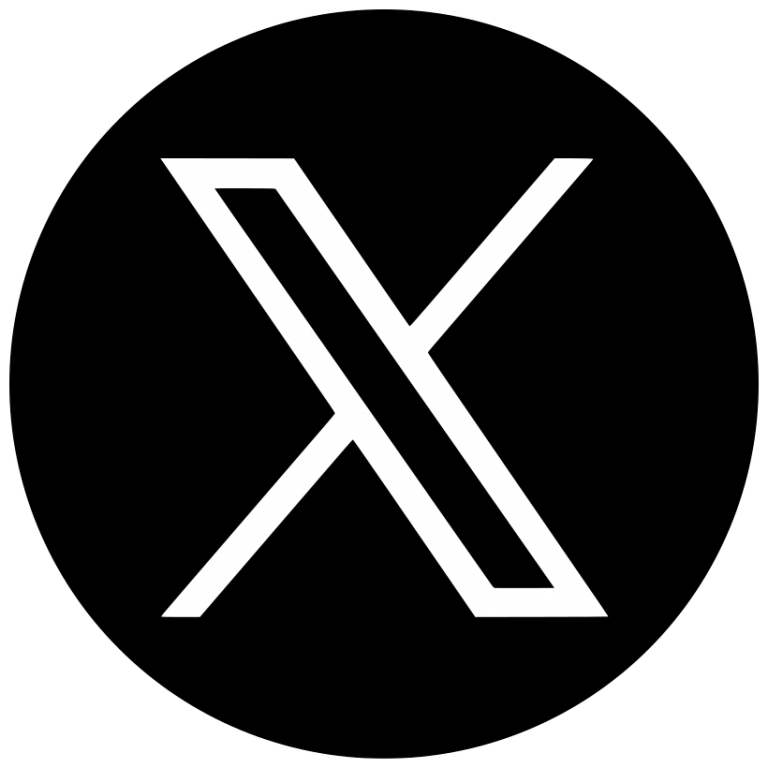Electricity Block/Step Tariffs Explained
The South African prepaid electricity market can be confusing. And arguably nothing else adds to this confusion more than block tariffs.
We’ve all seen it: You buy R500’s electricity at the beginning of the month and get a certain number of kilowatt units. You then make another R500 purchase a couple of days later and get almost 50% less units!
How can this be?
How much of what we hear about block tariffs is actually true?
How can we make sure that we don’t overpay for our electricity units?
Of the 100+ municipalities that Prepaid24 services (representing over 96% of South Africa’s municipalities), more than 85% employ step tariffs. That’s much more than one would expect, right?
Which makes this article all the more important, as we strive to answer the above questions for electricity consumers all across the country.
Why Do We Have Block Tariffs?
Block tariffs were introduced by municipalities in order to incentivise residents to consume less electricity. This came as a result of Eskom’s generation challenges and the fact that Eskom penalises municipalities for putting too much strain on its capacity and delivery.
The way block tariffs achieve this goal is by making electricity units more expensive for residents as they move up through purchase brackets, which have ascending rates per unit (kWh). The end result of this is that residents who consume higher volumes of electricity will end up paying more per unit.
With this system, the only way to reduce your cost per unit is to use less electricity and avoid spending too much money in the upper brackets of your municipality’s tariff structure.
How Do Block Tariffs Work?
As mentioned above, block tariffs make units more expensive as residents move up through several unit brackets known as “blocks” or “steps” (hence, then name “block/step tariffs”).
If you use very little electricity, block tariffs are structured in such a way that you will pay considerably less per unit (kWh) than someone who uses a large amount of electricity. For these consumers, the structure holds no real penalties, as they never reach the higher tariff steps/blocks.
An example of municipal unit brackets or tariff steps is as follows (City of Cape Town 2023/24):
Block 1: 0 - 50 kWh (R2,67/kWh)
Block 2: 50,1 - 350 kWh (R2,98/kWh)
Block 3: > 350,1 kWh (R3,10/kWh)
Theoretically, if you always use less than 50 units per month (unlikely as this may be), you will only ever pay R2,67 per unit. But, as soon as your monthly purchase total exceeds 50 units, you will be moved into the higher tariff blocks in which your electricity will be charged for at higher rates. You will still get your first 50 units at the lowest rate, but your next units will be charged at the higher blocks’ rates as you move through these brackets.
It’s important to note that blocks can never be skipped and that municipal block/step tariffs reset to Block 1 at the beginning of each calendar month, leading people to think that it’s cheaper to buy electricity at the beginning of the month vs. the end of the month (we address this in the next “Electricity Tariff Myths” section).
Electricity Tariff Myths
Because municipalities don’t always do a great job of explaining block tariffs to residents, many people have been left to their own devices, formulating theories largely based on their own personal experiences. This has led to a mixture of truth and “urban legend” doing the rounds on social media and around “braaivleis” discussions.
And as we know, a half-truth can often do more damage than a full-out fallacy or lie, because of its believability…
We’re here to bust these myths and give you certainty as to how block tariffs function.
Myth 1:
“It’s cheaper to buy electricity at the beginning of the month vs. the end of the month.”
Prepaid24 Answer:
Technically, yes. (But there’s a lot more to it than that. Let’s explain:)
The reason why electricity seems cheaper at the beginning of the month vs. the end of the month is two-fold:
1. Municipalities reset their step tariffs at the beginning of each calendar month.
A municipal block tariff keeps track of how many units (kWh) you purchase during the month, and this running “counter” resets to zero at the beginning of each new month. The more units you buy during a month, the more expensive your units become (as you move through your municipality’s tariff steps). Thus, after resetting to zero, a block tariff once again charges you at the lowest rate for your units when making your first purchase of the new month.
2. Most people make their first electricity purchase of the month quite early in the month.
As a matter of habit and monthly routine, most people buy electricity somewhere between the 1st and 5th of the month (Prepaid24’s purchase data backs this up). This, of course, is shortly after municipalities have reset their block tariffs to zero, meaning that everyone starts purchasing in Block 1 again – in which units are the cheapest. Because their Block 1 units are consumed by their first purchase, their purchases later in the month are made in the higher tariff blocks – in which they are charged higher rates per unit.
Therefore, because most people make their first purchase (or what we may call their “Block 1 purchase”) at the beginning of the month, many consumers conclude that electricity must be cheaper at the beginning of the month. But this is not necessarily true.
You see, it has nothing to do with timing and everything to do with how much you’ve already purchased in the new month.
If someone were to make their first electricity purchase of the month on the 25th or 30th of the month, they would still be in Block 1 and would still get their units at the lowest price – just like the people who bought early in the month. That is because municipal block tariffs do not look at WHEN you buy electricity but rather at HOW MANY units you have purchased during a calendar month.
A more accurate statement, therefore, is that electricity is cheaper in the lowest block of a municipal tariff structure (i.e. Block 1), regardless of whether it’s at the beginning or end of the month. As long as you have not purchased units and moved out of Block 1 during a given month, you will get your units at the cheapest possible price, even if that purchase is made on the last day of that month.
Myth 2:
“It’s cheaper to buy all your month’s electricity at once and not in broken/split up amounts.”
Prepaid24 Answer:
No.
Block tariffs do not take the number of PURCHASES into account, but rather keep track of HOW MANY units (kWh) you have purchased during a calendar month.
You could make 3 purchases during the month and move through your municipality’s tariff blocks in several “jumps”, or you could swiftly move through all the blocks at once with a single purchase. As long as you purchase the same Rand amount, you will get exactly the same number of units (kWh) from your municipality in total.
Whether you want to buy once or multiple times during a month comes down to personal preference and how you like to manage your purchases and cashflow.
(Refer to the “Purchase Examples” section of this article for a visual breakdown of how a single purchase compares to 3 split purchases).
Practical Example:
Sometimes numbers help us to understand concepts better than words do.
Let’s take Pete as an example.
Pete lives in Cape Town and uses R1 500’s electricity on average every month. One month, he decided to buy all his electricity with a single payment, and the next month he chose to break up his purchases into 3 x R500 recharges. Here is a visual breakdown of his purchases:
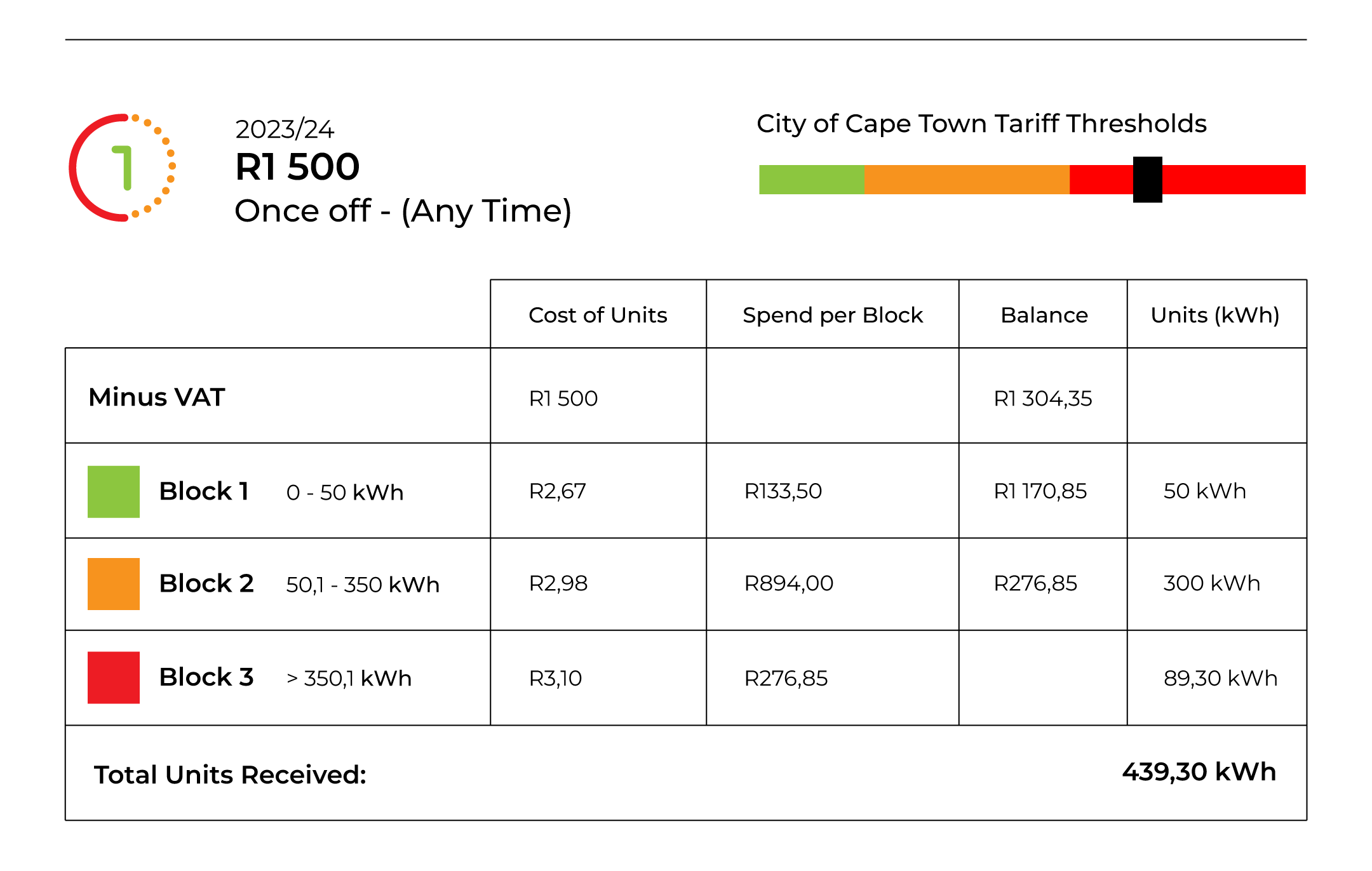
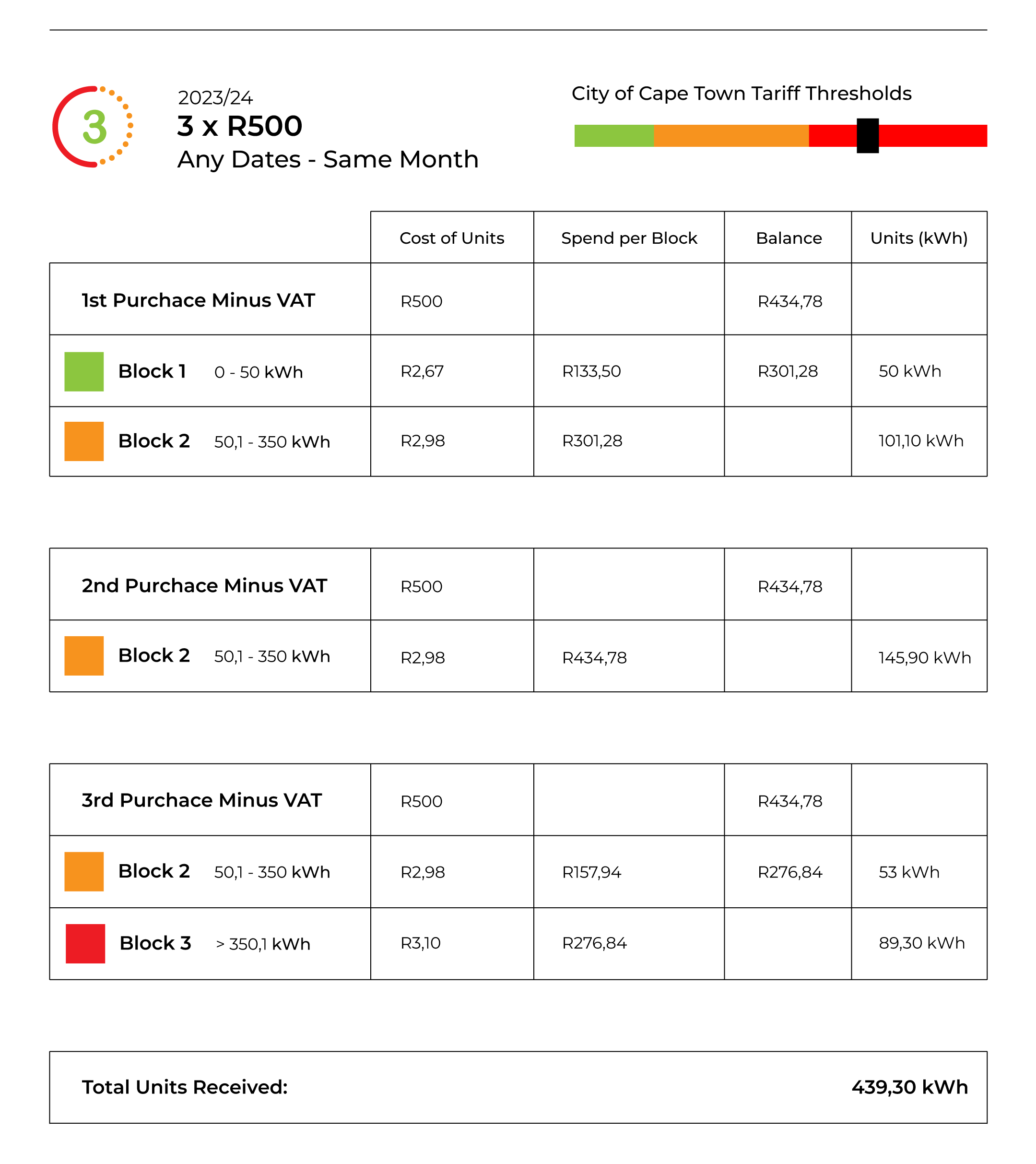
As you can see, Pete received 439,30 kWh in both months, regardless of whether he bought all his electricity at once or chose to make multiple payments at different times of the month.
You don’t need to buy on a specific day of the month, nor do you need to scientifically calculate your purchase amounts to the nearest millionth! None of us need that added pressure in our lives.
Myth 3:
“It’s cheaper to buy in bulk, for multiple months in advance.”
Prepaid24 Answer:
No.
This is a misconception that comes from our idea of “wholesale” or “bulk” purchases of other household products, which are usually cheaper per item when you buy them in high volumes. This, however, is not the case with prepaid electricity at all.
In fact, buying electricity in bulk can be very damaging to your budget and cause you to lose out on a lot of value. Here’s how:
- By skipping months with your electricity purchases, you are missing out on the cheap Block 1 units that are available to you every month. Unpurchased Block 1 units do not carry over to the next month, so you will not get access to them again. Thus, if you want to make sure you extract as much value out of your electricity purchases as possible, make sure that you at least buy your Block 1 units every month.
- By buying several months’ units in advance, you will be purchasing the large majority of those units in the top block of your municipality’s tariff structure, where units are the most expensive they can be. Remember, your municipality does not know you’re actually buying in advance. Their block tariff will simply treat you like a massive electricity consumer and charge you the maximum rate for your units, meaning that you will drastically overpay.
Thus, buying electricity in bulk for many months in advance to cover your household’s normal consumption, will mean that you miss out on your cheap Block 1 units in many months and will also cause you to overpay for the vast majority of the units you buy, as they will be purchased in your municipality’s top tariff bracket.
Practical Example:
Let’s take Sandy as an example.
Sandy lives in Johannesburg with her husband and 2 children. She used to buy R6 000’s electricity for her household once every 3 months, because it saved her time and she thought it would work out the same as buying smaller amounts every month.
After speaking to a Prepaid24 consultant, she discovered that buying bulk actually ends up being more expensive, she decided to buy R2 000 every month for 3 months, to test if she actually got more units. Here’s a breakdown of her purchases:
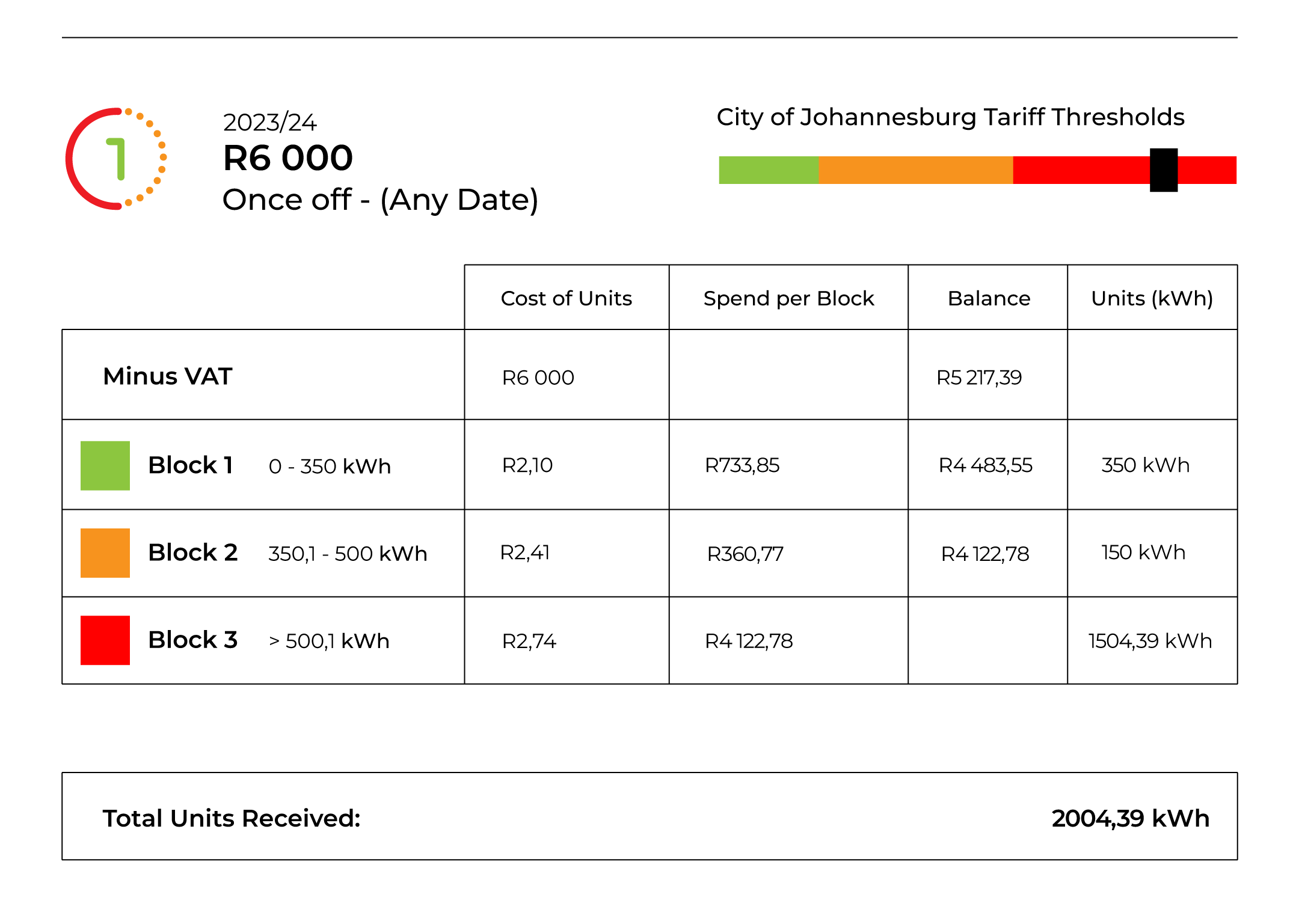
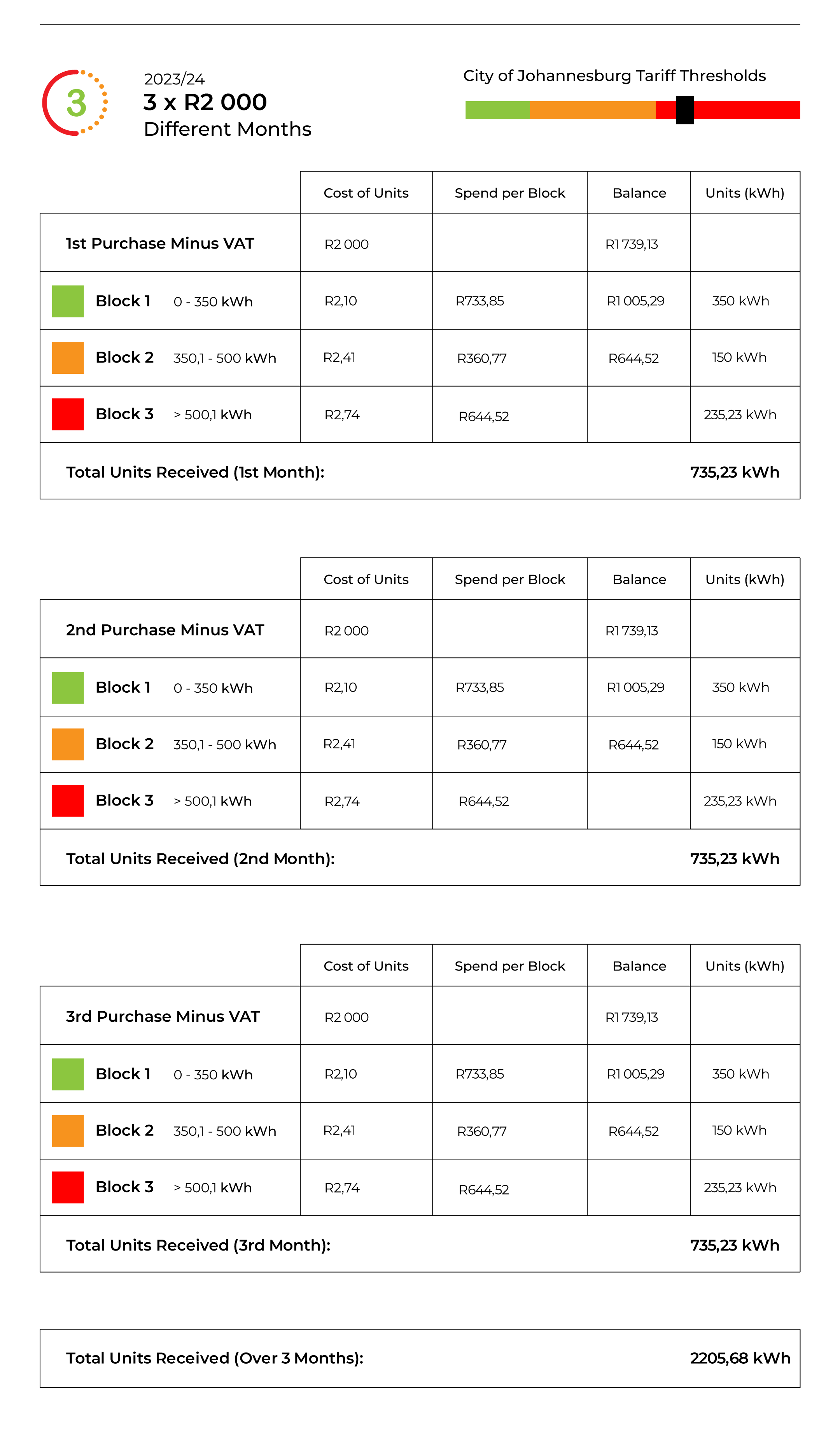
Sandy got 201.29 more units when she bought electricity every month instead of making bulk purchases in advance – that despite her total spend being the same (R6 000 over 3 months). Incredible!
Prepaid24 clients who receive our Monthly Electricity Breakdown will be able to verify these facts. In this free monthly report, we give you last month’s purchases, tokens and units (kWh) received, as well as a 12-month overview of your purchases, spend and units (kWh) received.
How To Make Sure You Don’t Overpay
The answer to this question is very simple: Only buy as much electricity as you actually consume during a month.
Why? Because block tariffs are set up in such a way as to charge larger electricity consumers higher rates per unit (in order to incentivise people to use less electricity), any “extra”/”leftover” units that you buy during a month will typically be purchased in the top, most expensive block of your municipality’s tariff structure.
Thus, as savvy South African electricity consumers, our goal should be to not buy ANY unnecessary units in the top blocks of our municipal tariffs. Yes, most of us will need to buy some units in our top tariff block to make sure we have enough units to carry us through the month, but if we see that we consistently have 100 kWh left at the end of the month (for example), we would be wise to reduce our monthly purchase amount. By doing so, we will ensure that we do not unnecessarily overpay for any of our units.
Another helpful financial tip is to buy electricity EVERY SINGLE MONTH so that you capitalise on the cheap Block 1 units you get access to every month. Even if you have enough units on your meter, it is still a good idea to buy up these cheap units on a monthly basis, so that you don’t have to go into more expensive blocks in future months and can perhaps start building up a unit “buffer” against Eskom’s annual price increases.
It is our hope that this article has helped you get a better grip on how municipal block/step electricity tariffs work. We believe that information is power, and our mission is to make sure that you are always informed around prepaid electricity, so that you can get maximum value from your monthly purchases
Reach Out To Us
If you have any questions or would like one of our expert consultants to do a personalised tariff calculation for you (subject to the availability of your municipality’s tariff breakdowns), please reach out to us on Prepaid24 Support. As South Africa’s online electricity partner, we’re here to help.
Any suggestions for this or future articles will be most welcome. Please also send these through to Prepaid24 Support.
Quick Questions
- Did you find this article informative?
- Do you have a better understanding of how electricity block tariffs work?
- If you do, will you kindly share the LINK to this article with one friend, to help them understand this important topic as well?
By sharing this article with family and friends, you’re helping us to make sure that at least one part of the South African electricity sector is well serviced and understood.
Share this article with friends & family!
f


